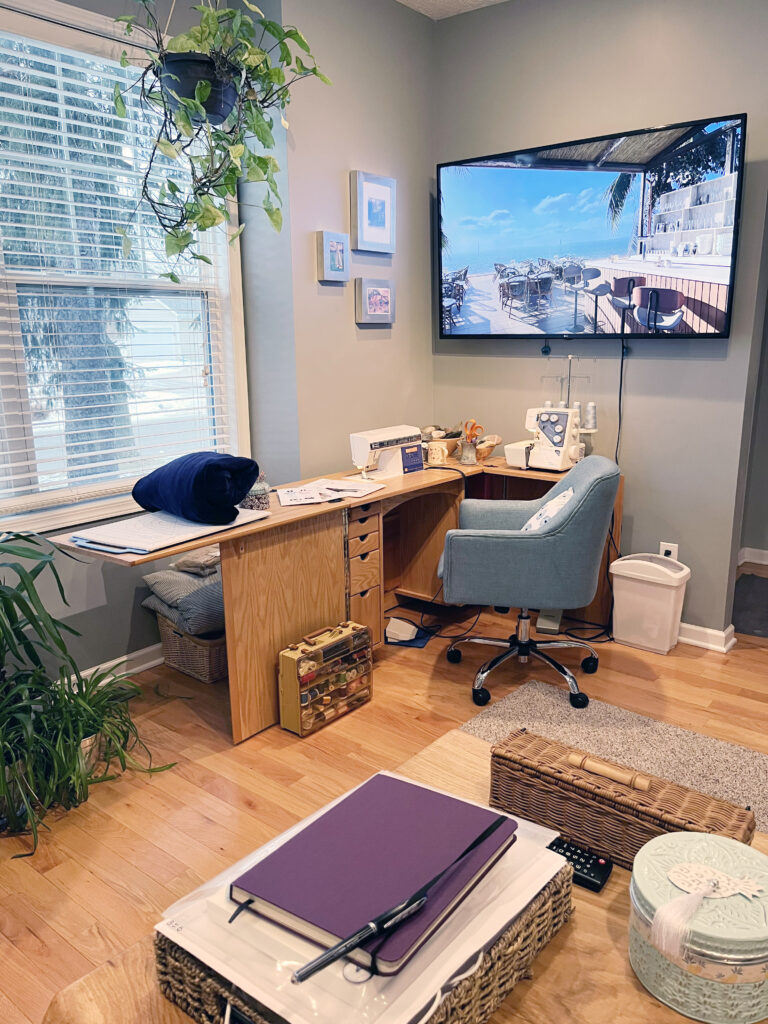Making time to sew. Making time. What a weird phrase. We don’t make time, we have it. And no matter how rich we are, or poor, we all get the exact same 24 hours per day. Sometimes some of us get more years in that (more on that to come) and some get less, but time is a fixed commodity. So how do we MAKE TIME to sew?

I turned on screen time (apple, iPhone) for myself when I did so for my kids – and I did not, purposefully, share across all devices, because this Mac, the one that I’m writing this on, is my work computer and I’m on it from 9am to 5pm with a one hour lunch, that sometimes, I’m on it too. And my iPad, let’s not forget that too. So across just one device (my phone) I spend upwards of 2 hours a day on it. What could you do with an extra two hours in your day? Yep, me too.
Making time to sew means making a commitment to sew. What do you do when the commitment seems overwhelming?
I start with mending. Yes, I know, that seems ridiculous, but sometimes just fixing that button or sewing on a Scout patch, takes like ten minutes, and then, I’m in the groove, at my machine, in my sewing/office chair (I have one chair in here, roll it between stations.)
But once I want to move on to another project, sometimes I stop. You probably do too. A few days, a week, a month, two go by and before you know it, you haven’t sewn in three months!
I like to daydream about sewing – you probably do too. Those projects we’d like to make, the things they’d go with, how they’d be PERFECT. But until we get to making, they are just dreams. Turning them into reality takes commitment, activity.
Making time to sew is about creating a habit using a place, and a process. The habit of sewing comes from having a place, and a process to get started. Once it becomes a habit, something you choose regularly, you’ll sustain that maker energy.
About a year ago, at the behest of my functional medicine physician (she’s a D.O. who practices holistic or functional medicine), I started Ann’s Hour – from 8-9am every day. Once upon a time this was a commute – driving kids to school 10 miles away, going to my office another 10. But when I moved my office home, and my kids to local neighborhood schools in 2015, I started working at 8 – that creep back into my time seemed so easy.
I took it back in the form of meditation, stretching, yoga and occasionally weightlifting or dog walking. I took it back to sew, originally, but that isn’t my best time to sew, so I do the other, physical things, early in the day, leaving me with…no time to sew later in the day? What?
Walk then sew
I now walk my dog at 4:45 every day. That fifteen minute or 30 minute “commute” home (I work from home) before I have to take kids to practice is mine. Very often I’m then driving a kid somewhere – but two days per week I’m just driving locally, dropping a kid off, and coming back home. For one blissful hour – or hour and a half – I can sit down and sew. It’s probably 6pm or 7pm, but I can do it (the other days of the week, I’m driving a couple of hours to practice or games.)
Getting yourself physically out of your house, transitioning your brain helps you come back in and sit down to sew.
That’s not the only thing holding you back though, is it. WHAT to sew is next. Like you, I spend time sketching, writing, planning, pinning things on Pinterest, scrolling Instagram. Making the choice to make something is hard.
I always start first by committing to making three of any pattern when I first make it. The first is some random fabric from my stash – either a friend-gifted or a cheaper piece of fabric. I make it in fabric recommended (knit or woven) for the pattern, but I make it in something that’s less serious. So then, I can commit to the pattern. I use my Pick One Sew Two (or Pick Two Sew One) method of matching that item to something already in my closet – no orphan garments here.
There are a bunch of sewing planners out there – Seamwork has a free one, HotPatterns had one in 2021 you can still get online (nevermind the dates on the calendar itself.) I’ve got one for free here too.
Pick one thing to sew. Start with a pattern and a piece of fabric. Your first sewing day/hour is to read the instructions over so you know what you’re in for. Your next sewing day/hour is tracing or cutting the pattern. Your third hour is sewing. In a week’s time (assuming you can find 3 hours in your week that you’re not scrolling your phone…) you will have a cut-out garment. In 5 days’ time, depending on the pattern, you might have a completed garment.
Let that sink in, did you think you’d ever sew a garment a WEEK? Or even every other week? That’s 52 items a year (or 23). Forget make nine, you’ll blow past that easily!
What separates this from just sitting down once a week and trying to find two or four hours at a time to sew is you’re incorporating this into your everyday life.
You are making time to sew. Or, in your case, grabbing the time you already have and using it.
If it’s time you are looking for, turn on screen time on your phone. Carve out early or late hours to sew or plan. I can’t sew really late at night – I make mistakes and get frustrated, but I can do my planning, reading of instructions.
If it’s what to sew or planning that has you stumped, go get one of the sewing planners I mentioned, and stand in your closet for 10 minutes, picking out things you don’t wear much because you don’t have things to go with them.
The last piece of this make time to sew is place. You need a place to sew. If you’re a kitchen table sewist, I highly recommend having a sewing box or crate or basket that you can keep a work in progress/sewing notions handy in your kitchen, with your machine nearby – a great way to do this is to clean out a lower cabinet in your kitchen and use that! If you do not have that space, a basket for notions with your machine beside it is a solution. If you can spare a small sewing table of some sort, use that – every year cheap, small student desks proliferate on the curbs in my college town – these are generally functional, maybe a little dented, but absolutely free. A little spray paint and you’re good to go. A small sewing table in your dining room or living room corner gives you a space to sew. Heck, you might have a spot in your bedroom or a closet you can use.
I have a sewing cabinet in my home office, so I have to pull my machine out and set it in the table. It takes one minute to open up the cabinet and get ready to sew. That’s what you need – a minute or two – so craft your best spot for this and go for it.
Making time (space, energy) to sew is investing in YOU. That act of sewing is an act of creativity, of healing, of restoration, of self care for you – and you get clothing or accessories out of it!
